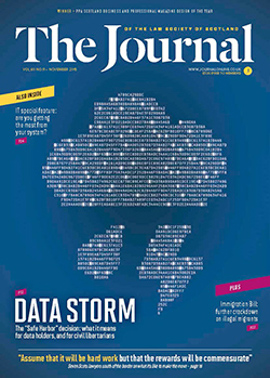Mediation minefield

It is sacrosanct in mediation circles that what happens in mediation, stays in mediation. The Civil Evidence (Family Mediation) (Scotland) Act 1995 provides in s 1 that “no information as to what occurred during family mediation to which this Act applies shall be admissible as evidence in any civil proceedings”. In FJM v GCM [2015] CSOH 130 (29 September 2015), the Act was considered in relation to a petition for orders under the Child Abduction and Custody Act 1985 for the return of two children to the country of their habitual residence.
The Lord Ordinary (Stewart) said that there are three remarkable things about the 1995 Act. (i) It is very short. (ii) It has never before been interpreted by the courts. (iii) Those forming the legislation did not give sufficient attention to the international child abduction dimension. FJM provides a careful first interpretation of the Act. It considers the child abduction dimension in detail. And there are remarkable things about this decision which could have profound repercussions for mediation practitioners.
Background
The parties were married, with two children aged eight and six years. Both parents had parental rights for the children, who had been born and brought up in Australia and had dual British and Australian nationality. After the relationship between the parents broke down in December 2014, the children’s mother took them to Scotland without the father’s knowledge and consent. In May 2015, the father petitioned the Scottish court for the children’s return to Australia.
During the intervening six months he had travelled to the UK and stayed in England. The parties entered mediation with a view to resolving differences about where they, and their children, should reside and what arrangements should be made for their property in Australia. During a mediation session the parties appeared to agree on next steps in the short term. The father wrote a note for the mediator listing the points of agreement. These were subsequently expanded by the mediator in a typewritten summary which purported to record an “Understanding made between CM and FM” at mediation.
The court considered two versions of this summary. The earlier version stated: “Both parties mutually agreed that Mum will reside in Scotland with the children.” The second version recorded: “Mum residing in Scotland with the children (to be discussed at next session).”
The mother acknowledged that she had wrongfully removed the children from Australia. She argued that the father had subsequently acquiesced in the wrongful removal by virtue of the agreement reached in mediation and had therefore relinquished his Hague Convention right to insist on the children’s return to Australia. The father argued that evidence of what occurred during the mediation was inadmissible under the 1995 Act. The mother argued that under s 2(1)(a) of the Act, evidence as to any contract entered into during family mediation, or of the fact that no contract was entered into, was admissible and that “contract” included an agreement of the kind the parties’ mediator had recorded.
Acquiescence or no?
First of all, the court found that, on the basis of the evidence, including evidence from the mediation, the father did acquiesce in the removal of the children from Australia. It made a finding in fact that the parties’ mutual understanding was that the children would live in the UK. Thereafter the question for the court was whether or not the 1995 Act applied in this situation, and if so, whether the mediation evidence on which the court had relied was admissible; that is, whether the “understanding made between the parties” was a contract about which the Act permitted evidence to be led.
Family mediators might have considered that the circumstances of this case would attract the protection of the 1995 Act in terms of s 1(2)(a), which states that the Act applies to “family mediation between two or more individuals relating to – (i) the residence of a child; (ii) the regulation of personal relations and direct contact between a child and any other person; (iii) the control, direction or guidance of a child’s upbringing; (iv) the guardianship or legal representation of a child; or (v) any other matter relating to a child’s welfare”. These categories relate to the exercise of parental responsibilities and rights. The range of mediations to which the Act applies is potentially wider than the range of family actions which the Court of Session can refer to mediation. The court concluded that the category is nevertheless restricted and does not include child abduction, even if wrongful removal does impact on the exercise of these parental rights.
In the absence of precedent or authorities to assist the court in interpreting the 1995 Act, the Lord Ordinary himself explored the underlying history and emerging policy around the Act, family mediation and its interface with the courts. He also reviewed the Hague Convention and EU guidance on mediation in child abduction cases. He concluded that:
- The 1995 Act’s focus is primarily on court-ordered mediation.
- Although it applies to a wide range of family proceedings, it does not apply to cross-border abductions.
- The definition of family proceedings in which mediation may be ordered by the courts does not include Hague Convention proceedings.
- Mediation is an entirely appropriate method of resolving Hague Convention abduction disputes; however there may be an obligation on a mediation practitioner to share information about the content of mediation in order to prevent unlawful removal of children.
- The 1995 Act only makes evidence from and about Scottish mediations inadmissible, not evidence about mediation which takes place in jurisdictions outwith Scotland.
In the light of the foregoing, he found that child abduction disputes must be excluded from the ambit of the 1995 Act; exclusion of evidence about potential wrongful removal from the courts cannot be justified, and in any event, other than in extreme cases, Hague cases are not generally about a child’s welfare. Other considerations such as prompt return to the appropriate jurisdiction, and prevention of potential crime and public disorder, take precedence over the parties’ rights to confidentiality in these kinds of disputes.
Because he determined that the Act did not apply to the parties’ mediation the Lord Ordinary did not rule on the point, but he indicated that, if he had determined that the Act did apply, nonetheless the documents from Family Mediation narrating the “understanding” between the parties might still be admissible evidence under the exception in s 2(1)(a), as information about “contracts” entered into during mediation. That has significant implications for mediators when preparing mediation summaries for parties.
Thankfully, the Lord Ordinary also did not take a view on “whether the mere fact of engaging without reservation in mediation in the destination state, about arrangements for residence and contact in the destination state… in itself amounts to acquiescence”. If he had, and he determined that it did, any prospect of access to mediation before court proceedings in Hague cases might effectively be ruled out. That might also have a chilling effect on early mediation in other cases.
Correspond with caution
Another interesting facet of the case was the extent to which the parties’ email correspondence with each other and third parties became the focus of the court’s scrutiny. The court relied on this in its assessment of whether the father had acquiesced in the children’s removal. The father sought to explain away the content of his communications, saying in affidavit evidence that “he did not mean what he said in emails and telephone conversations”. The court clearly relied on these alongside the father’s actions in arriving at the view that he acquiesced in the children’s removal. Parties need to be aware that disingenuous, careless or intemperate correspondence may come back to haunt them.
The principle of confidentiality is inviolable in mediation practice. It allows mediators to help parties explore a wide range of options for resolving their disputes, without fear that engaging in such exploration will prejudice their position further down the line. Knowing that what they say in mediation will not be open to external, and possibly hostile, scrutiny facilitates greater openness between parties. It helps them focus on finding solutions, rather than protecting positions.
The code of practice for lawyer mediators in Scotland states that the mediation process is conducted on a “without prejudice” basis, and any statements and negotiations made during mediation cannot be founded on in any court action save with both parties’ consent. Mediators might presume that the 1995 Act provides protection for the whole of their practice. This decision suggests that the Act’s application is more limited than parties and their lawyers, and most importantly, mediation practitioners, perhaps have taken for granted.
In this issue
- Appropriate adults and defence agents: who does what?
- Buying from a housing association: why consent matters
- Harassment: a civil claim?
- A welcome abroad: EYBA in London
- Reading for pleasure
- Opinion: David Faith
- Book reviews
- Profile
- President's column
- ScotLIS gets the green light
- People on the move
- Storm over Safe Harbor
- Light on a murky world
- Southern horizons
- Mediation minefield
- Migrants: no way to turn?
- The technological edge
- As our suppliers see us
- More rules to grapple with
- Fraud and divorce – a Scottish Sharland?
- What future for employment tribunal fees?
- Heading for a showdown on hard won human rights?
- Taxing question of relief
- Scottish Solicitors Discipline Tribunal
- How far can we rely on the register?
- All part of the game
- Law reform roundup
- From the Brussels office
- Poverty: a new front in the war
- Damage limitation: working it out
- Ask Ash
- A lawyer's lament
- Appreciation: Michael Scanlan






